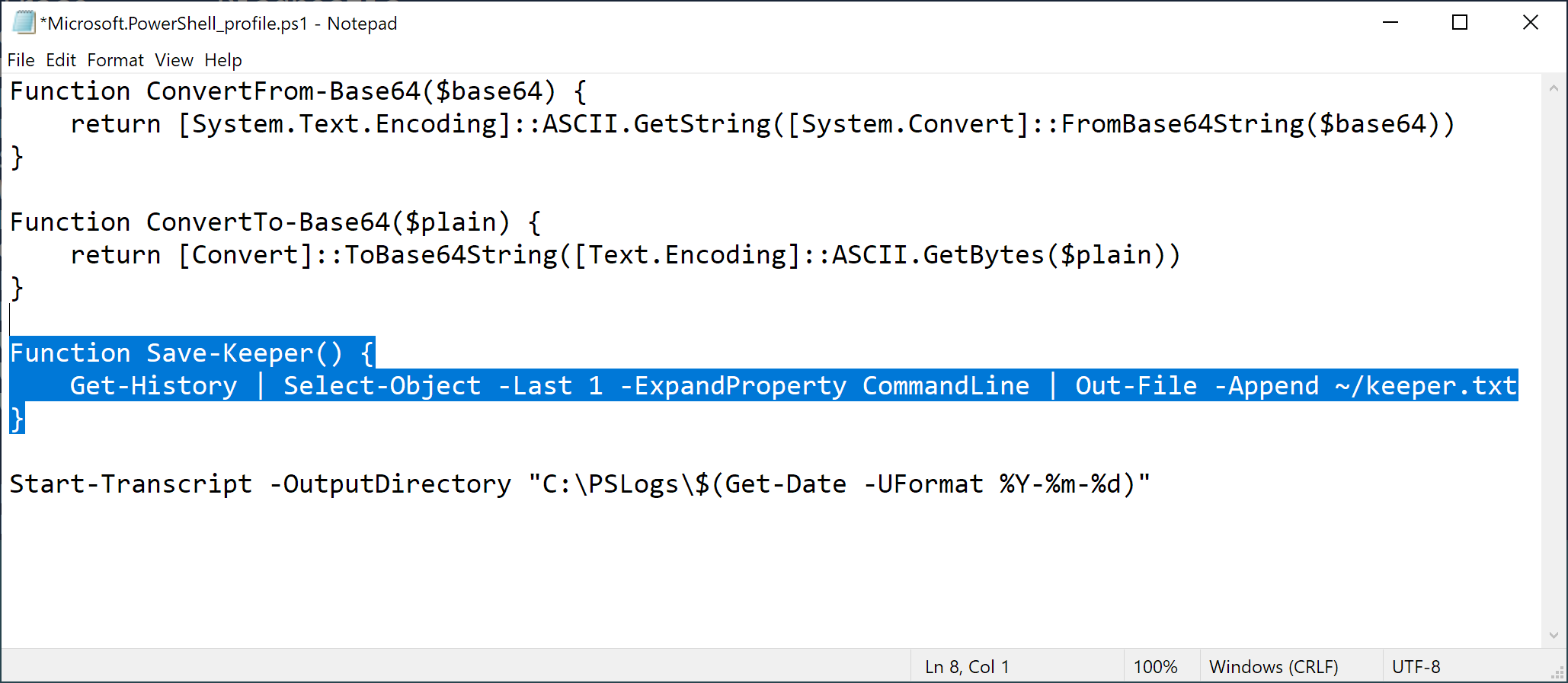SEC504: Hacker Tools, Techniques, and Incident Handling


Experience SANS training through course previews.
Learn MoreLet us help.
Contact usConnect, learn, and share with other cybersecurity professionals
Engage, challenge, and network with fellow CISOs in this exclusive community of security leaders
Become a member for instant access to our free resources.
Sign UpMission-focused cybersecurity training for government, defense, and education
Explore industry-specific programming and customized training solutions
Sponsor a SANS event or research paper
We're here to help.
Contact UsLet's build a useful PowerShell function to save useful commands for later reference: Save-Keeper!

My why did we pick a month with 31 days co-conspirator for the Month of PowerShell Mick Douglas offered up a quick Bash function a while back called [code]keeper()[/code]:
keeper() {
fc -ln | tail -n 1 >> ~/.keeper.txt
}I added it to my [code].bash_profile[/code] script, and whenever I'm particularly pleased with a Bash command that I want to save for future reference, I run [code]keeper[/code]:
PrintExport-5x7 $ ls
Crop-5x7-DSC_4745.jpg Crop-5x7-DSC_4947.jpg Crop-5x7-DSC_5043.jpg Crop-5x7-DSC_5296.jpg
Crop-5x7-DSC_4791.jpg Crop-5x7-DSC_4973.jpg Crop-5x7-DSC_5187.jpg Crop-5x7-DSC_5312.jpg
Crop-5x7-DSC_4830.jpg Crop-5x7-DSC_5035.jpg Crop-5x7-DSC_5217.jpg
PrintExport-5x7 $ for image in *.jpg; do newimagename=${image#Crop-5x7-}; echo "Renaming $image to mv $newimagename" ; mv $image $newimagename; done
Renaming Crop-5x7-DSC_4745.jpg to mv DSC_4745.jpg
Renaming Crop-5x7-DSC_4791.jpg to mv DSC_4791.jpg
Renaming Crop-5x7-DSC_4830.jpg to mv DSC_4830.jpg
Renaming Crop-5x7-DSC_4947.jpg to mv DSC_4947.jpg
Renaming Crop-5x7-DSC_4973.jpg to mv DSC_4973.jpg
Renaming Crop-5x7-DSC_5035.jpg to mv DSC_5035.jpg
Renaming Crop-5x7-DSC_5043.jpg to mv DSC_5043.jpg
Renaming Crop-5x7-DSC_5187.jpg to mv DSC_5187.jpg
Renaming Crop-5x7-DSC_5217.jpg to mv DSC_5217.jpg
Renaming Crop-5x7-DSC_5296.jpg to mv DSC_5296.jpg
Renaming Crop-5x7-DSC_5312.jpg to mv DSC_5312.jpg
PrintExport-5x7 $ keeper
PrintExport-5x7 $ tail -1 ~/.keeper.txt
for image in *.jpg; do newimagename=${image#Crop-5x7-}; echo "Renaming $image to mv $newimagename" ; mv $image $newimagename; doneIn this Bash example, I used a [code]for[/code] loop to rename a bunch of files, removing the [code]Crop-5x7-[/code] beginning of the file name using the Bash shell parameter expansion feature [code]{image#Crop-5x7-}[/code]. Then, because I was pretty pleased with myself, I ran [code]keeper[/code] to save that command to [code]~/.keeper.txt[/code] so I could reference and reuse it later.
We can use [code]Get-History[/code] to see a list of commands that we ran in the current session:
PS C:\Users\Sec504> Get-History
Id CommandLine
-- -----------
1 Get-WmiObject -Class Win32_Product
2 $InstalledSoftware = Get-ChildItem "HKLM:\Software\Microsoft\Windows\CurrentVersion...
3 foreach($obj in $InstalledSoftware){write-host $obj.GetValue('DisplayName') -NoNewl...
4 $InstalledSoftware = (Get-ChildItem "HKLM:\Software\Microsoft\Windows\CurrentVersio...
5 $InstalledSoftware = (Get-ChildItem "HKLM:\Software\Microsoft\Windows\CurrentVersio...
6 $InstalledSoftware = Get-ChildItem "HKLM:\Software\Microsoft\Windows\CurrentVersion...
7 ForEach-Object ($obj in $InstalledSoftware){ Write-Host $obj.GetValue('DisplayName'...
8 foreach ($obj in $InstalledSoftware){ Write-Host $obj.GetValue('DisplayName') -NoNe...The parameter [code]CommandLine[/code] is what we want, and can use [code]Select-Object -Last 1[/code] to retrieve the last command:
PS C:\Users\Sec504> Get-History | Select-Object -Last 1 -Property CommandLine
CommandLine
-----------
foreach ($obj in $InstalledSoftware){ Write-Host $obj.GetValue('DisplayName') -NoNewline...Perfect! Now, just add the [code]Out-File[/code] to save to [code]~/keeper.txt[/code] (I'm recalling the previous [code]foreach[/code] command before running [code]Get-History[/code] for consistency in examples):
PS C:\Users\Sec504> Get-History | Select-Object -Last 1 -ExpandProperty CommandLine | Out-File -Append ~/keeper.txt
PS C:\Users\Sec504> Get-Content C:\Users\Sec504\keeper.txt
foreach ($obj in $InstalledSoftware){ Write-Host $obj.GetValue('DisplayName') -NoNewline; Write-Host " - " -NoNewline; Write-Host $obj.GetValue('DisplayVersion') }
PS C:\Users\Sec504>A couple of things to point out here:
Next, all that is needed is to add this as a function to the PowerShell profile:
PS C:\Users\Sec504> notepad $profile
PS C:\Users\Sec504>To keep with the Verb-Noun convention, I called this [code]Save-Keeper[/code]:

Here is the function to copy-paste into your PowerShell profile.
Function Save-Keeper() {
Get-History | Select-Object -Last 1 -ExpandProperty CommandLine | Out-File -Append ~/keeper.txt
}Then you can close and open a new PowerShell session, or reload your PowerShell profile:
PS C:\Users\Sec504> . $profileLet's put this new function to use. I want to build a list of installed software on Windows by enumerating the software uninstall keys for [code]HKEY_CURRENT_USER[/code] and [code]HKEY_LOCAL_MACHINE[/code]. First, identify the keys using [code]Get-ChildItem[/code] in the variable [code]$InstalledSoftware[/code]:
PS C:\Users\Sec504> $InstalledSoftware = Get-ChildItem "HKLM:\Software\Microsoft\Windows\CurrentVersion\Uninstall", "HKCU:\Software\Microsoft\Windows\CurrentVersion\Uninstall"
PS C:\Users\Sec504> Save-Keeper
PS C:\Users\Sec504>Next, get the [code]DisplayName[/code] and [code]DisplayVersion[/code] elements for each key:
PS C:\Users\Sec504> foreach ($obj in $InstalledSoftware){ Write-Host $obj.GetValue('DisplayName') -NoNewline; Write-Host " - " -NoNewline; Write-Host $obj.GetValue('DisplayVersion') }
7-Zip 19.00 (x64) - 19.00
-
-
-
-
Git version 2.21.0 - 2.21.0
-
-
-
-
-
Process Hacker 2.39 (r124) - 2.39.0.124
Rekall v1.6.0 Gotthard -
-
USBPcap 1.1.0.0-g794bf26-5 - 1.1.0.0-g794bf26-5
-
Update for Windows 10 for x64-based Systems (KB4480730) - 2.55.0.0
Update for Windows 10 for x64-based Systems (KB4023057) - 2.67.0.0
OpenCL™ runtime for Intel® Core™ and Xeon® Processors - 6.4.0.25
Microsoft Visual C++ 2013 x64 Additional Runtime - 12.0.40649 - 12.0.40649
Java 8 Update 111 (64-bit) - 8.0.1110.14
PowerShell 7-x64 - 7.2.3.0
Microsoft Visual C++ 2008 Redistributable - x64 9.0.30729.6161 - 9.0.30729.6161
Java SE Development Kit 8 Update 111 (64-bit) - 8.0.1110.14
Microsoft Update Health Tools - 3.67.0.0
Microsoft Visual C++ 2019 X64 Minimum Runtime - 14.24.28127 - 14.24.28127
Microsoft Visual C++ 2019 X64 Additional Runtime - 14.24.28127 - 14.24.28127
Microsoft Visual C++ 2013 x64 Minimum Runtime - 12.0.40649 - 12.0.40649
VMware Tools - 11.0.6.15940789
PS C:\Users\Sec504> Save-KeeperBy running [code]Save-Keeper[/code] after the commands, I can stash those commands in my [code]keeper.txt[/code] file:
PS C:\Users\Sec504> Get-Content C:\Users\Sec504\keeper.txt
...
$InstalledSoftware = Get-ChildItem "HKLM:\Software\Microsoft\Windows\CurrentVersion\Uninstall", "HKCU:\Software\Microsoft\Windows\CurrentVersion\Uninstall"
foreach ($obj in $InstalledSoftware){ Write-Host $obj.GetValue('DisplayName') -NoNewline; Write-Host " - " -NoNewline; Write-Host $obj.GetValue('DisplayVersion') }This works great, and I'll be sure to use it immediately after interesting commands to populate the [code]keeper.txt[/code] file with interesting tidbits.
Consider extending the [code]Save-Keeper[/code] function on your own to add some more features:
If you add these (or more) features to [code]Save-Keeper[/code], let me know! Tag me [code]@joswr1ght[/code] or [code]#MonthOfPowerShell[/code] in your tweet, DM me, or email me! Thanks!
-Joshua Wright
Return to Getting Started With PowerShell
Joshua Wright is the author of SANS SEC504: Hacker Tools, Techniques, and Incident Handling, a faculty fellow for the SANS Institute, and a senior technical director at Counter Hack.


As Senior Technical Director at Counter Hack and SANS Faculty Fellow, Joshua has advanced cybersecurity through ethical penetration testing, uncovering critical vulnerabilities across Fortune 500 companies and national infrastructure providers.
Read more about Joshua Wright